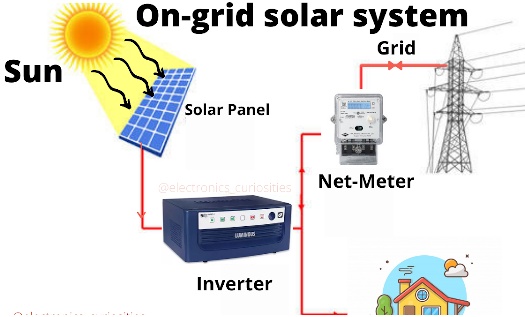An on-grid solar system, also known as a grid-tied or grid-connected solar system, is a renewable energy solution that harnesses sunlight to generate electricity while remaining connected to the local utility grid. This type of solar system consists of solar panels installed on rooftops or ground-mounted structures, which convert sunlight into electricity through photovoltaic cells. Unlike off-grid systems, on-grid solar systems do not require battery storage as they directly feed excess electricity back into the grid. This enables homeowners and businesses to offset their energy consumption with clean, renewable solar power while still accessing grid electricity when needed. Additionally, on-grid systems often incorporate net metering, allowing users to receive credit or compensation for the surplus electricity they generate. Overall, on-grid solar systems offer a sustainable and cost-effective way to reduce reliance on fossil fuels and contribute to a greener future.
How do on-grid solar systems work?
On-grid solar systems work by harnessing sunlight through solar panels, converting it into electricity, and feeding that electricity into the existing electrical grid. Here’s a step-by-step explanation of how they operate:
Solar Panels: Photovoltaic (PV) solar panels are installed on rooftops or ground-mounted structures. These solar panels contain multiple solar cells made of semiconductor materials, typically silicon, which generate electricity when exposed to sunlight.
Solar Energy Conversion: When sunlight hits the solar panels, the photovoltaic cells within the panels absorb the sunlight and generate direct current (DC) electricity. This electricity is generated as electrons are knocked loose from atoms in the semiconductor material, creating an electric current.
Inverter Conversion: The DC electricity produced by the solar panels is then sent to an inverter, which converts it into alternating current (AC) electricity. AC electricity is the standard form of electricity used in homes and businesses.
Grid Connection: The AC electricity from the inverter is then fed into the existing electrical grid through a bi-directional meter. This meter measures both the electricity consumed from the grid and the surplus electricity generated by the on-grid solar system.
Net Metering: In many on-grid solar systems, net metering is utilized. This means that when the solar system generates more electricity than is needed by the home or business, the excess electricity is fed back into the grid. The bi-directional meter tracks this surplus electricity, and the homeowner or business owner receives credit for it on their electricity bill.
Utility Grid Interaction: When the solar system doesn’t generate enough electricity to meet the demand of the home or business, electricity is drawn from the grid as usual. This seamless interaction ensures a continuous and reliable power supply, regardless of fluctuations in solar energy production.
Electricity Consumption: Electricity is consumed by the home or business in the usual manner, with any shortfall being supplemented by the grid as needed.
What are the benefits of an on-grid solar system?
On-grid solar systems offer several benefits, making them an attractive option for homeowners, businesses, and communities:
Reduced Electricity Bills: By generating their electricity from solar energy, users can significantly reduce their dependence on grid electricity, leading to lower electricity bills over time. In some cases, users can even generate surplus electricity and receive credit or compensation through net metering programs.
Financial Incentives: Many governments and utilities offer financial incentives, such as rebates, tax credits, or feed-in tariffs, to encourage the installation of on-grid solar systems. These incentives can help offset the initial cost of installation and make solar energy more accessible to a wider range of consumers.
Environmental Benefits: On-grid solar systems generate clean, renewable energy from sunlight, reducing the reliance on fossil fuels and the emission of greenhouse gases. By choosing solar energy, users contribute to mitigating climate change and promoting environmental sustainability.
Energy Independence: On-grid solar systems provide users with energy independence by allowing them to generate their electricity on-site. This reduces vulnerability to power outages and fluctuations in energy prices, providing greater control over energy costs and reliability.
Low Maintenance: Solar panels typically require minimal maintenance, with occasional cleaning and inspection to ensure optimal performance. Compared to other forms of energy generation, such as fossil fuel-based power plants, on-grid solar systems have lower maintenance requirements and longer lifespans.
Scalability: On-grid solar systems can be easily scaled up or expanded to meet changing energy needs. Additional solar panels can be added to the existing system as energy demand grows, providing flexibility and adaptability to users over time.
Job Creation and Economic Growth: The solar industry creates jobs in manufacturing, installation, maintenance, and other related sectors, contributing to economic growth and employment opportunities. By investing in on-grid solar systems, communities can stimulate local economies and support sustainable development.
Conclusion — On-grid solar systems represent a pivotal advancement in renewable energy technology, offering numerous benefits for both individuals and communities alike. These systems provide a sustainable and cost-effective solution to energy consumption by harnessing the power of the sun to generate electricity. Through their integration into existing power grids, on-grid solar systems reduce reliance on fossil fuels and contribute to a cleaner environment by lowering carbon emissions. Furthermore, by allowing excess energy to be fed back into the grid, these systems promote energy efficiency and facilitate the transition towards a more resilient and decentralized energy infrastructure. As we continue to confront the challenges of climate change and strive for a more sustainable future, the widespread adoption of on-grid solar systems holds great promise in shaping a greener and more sustainable world for generations to come.
How to Installation On grid solar Systems for Homes in India

6 min read
09 April
In case you have found a mistake in the text, please send a message to the author by selecting the mistake and pressing Ctrl-Enter.
Ujjawal Solar 2
Ujjawal Solar is a Solar Energy Company led and initiated by the students of the YMCA. We are India’s largest Mono PERC Solar modules manufacturer at PAN India...

No comments yet